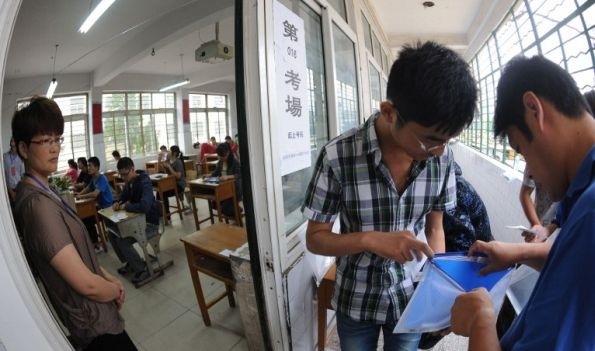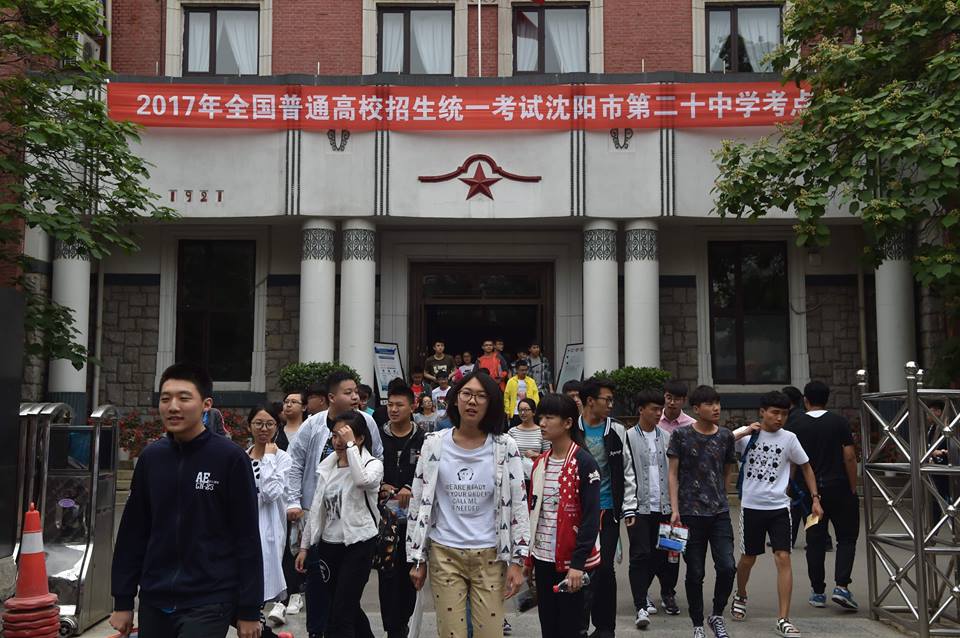

 字體:小 中 大
字體:小 中 大 |
|
|
|
| 2018/05/12 00:37:31瀏覽98|回應0|推薦0 | |
University entrance examsTesting timesJun 13th 2012, 9:18 by N.D. | SHANGHAI
AT THE gates of Shanghai Beijiao Middle School on the morning of the gaokao, students thumb their textbooks frantically. The number sitting China’s notoriously tough university-entrance exam each year is falling (6,000 fewer students took the exam in Shanghai this year; an effect of the one-child policy). But the atmosphere is as panicked as ever. A makeshift table sells traditional Chinese medicine to soothe nerves. Across China each year counselling hotlines are buzzing. Birth-control pills are administered to female students who fear menstruating on an inopportune day. Last month the Chinese media was ablaze with photos of students hooked to energy-boosting intravenous drips. More than 9m students sat the gaokaoon June 7th and 8th this year. For many, the exam comes as the culmination of months of cramming, years of tutoring and abnegated personal lives. The notoriously tough National Higher Education Entrance Examination, or gaokao for short, is a milestone for young Chinese people. Since it was established in 1952 (excepting an interruption by the Cultural Revolution) the two-day exam has been meant to elevate those who will benefit most from higher education while allocating places in a way that is fair to all. University admissions departments focus almost exclusively on the gaokao score. The result is colossal pressure on the test-taking students. At the gates of Shanghai Beijiao, Ms Yu wishes she had made her son Pan Ziren work harder. Though young Mr Pan has been rising at 5.30am and studying until 1am for the past six months, Ms Yu thinks he has wasted his years in school. He was addicted to kung-fu novels, she says. “I’d find him reading with a torch, deep in the night. Maybe it is my fault for going on about the importance of the gaokao. It caused his rebellious attitude.” Though each year more students go to university (the admission rate is up 3% this year) spots at elite institutions are oversubscribed. Less than 0.2% of gaokaotakers will get into China’s top five universities. Graduate opportunities for students who attend a top university are dramatically different to those who don’t, says Jeffrey Lehman, vice-chancellor of New York University’s branch campus in Shanghai. Peng Cheng, an 18-year-old student from Hunan province, has much to lose. “Studying is the only way to get out of my hometown”, he says. Mr Peng was one of only three students from his province, which has a population of 65m, selected for a special scheme at Tsinghua University in Beijing. Mr Peng gets an additional 30 points on his gaokaoscore, as well as guaranteed admission. Mr Peng’s handicap is part of an attempt by the university to redress a greater imbalance in Chinese education. Students sit the gaokaoin the place they are registered in the hukousystem, which has the effect of putting students from rural areas at a steep disadvantage. Close proximity of a test-taker’s registration to an institution raises the chance of admission; it is 16 times easier for a Bejiing student to get a place at Tsinghua than it is for a student from Hunan, where there are few first-rate options. Many urban students are registered in the countryside, so they return to the village for the exam. Last October a group of leading scholars submitted a petition to Wen Jiabao, China’s president, calling for the abolishment of the hukourestrictions. Mr He, a law professor at Tsinghua University and one of the petitioners, sees a further flaw in the gaokaosystem. It promotes the survival of the fittest, he says, but not of the best. The students are trained exclusively for the studying and answering of test papers. But the majority lack the skills to join in classroom discussion. Independence of thought is subordinated to the demands of rote learning. The students who emerge from this system often find it difficult to make basic social engagement, let alone intellectual collaboration. This was true for Mr Peng. Because he was star pupil, he was kept away from boys in class who could distract him. He has no friends, he says, and turns to internet cafes to ward off loneliness. But, gaokaoscore permitting, Mr Peng is now looking forward to his move to the big city. He hopes to find time for a girlfriend, and for other distractions besides. He fell in love with a girl at his high school. “But I knew a relationship would ruin my dream of getting out. So I never told her.” (Picture credit: AFP) Testing times Jun 25th 2012, 17:20
Every year in China, more than 1.2 million students walk across the test room for entrance exams of college, or Gaokao. The test divides into two parts - one for natural sciences (science) and another for social sciences (arts). There are many subjects chosen by college and dividing into two kinds - local 18 provinces or the union. During the recent 10-year evolution, including the abolition of “Mao’s thought” subject, Gaokao proceeds in dispute with the context, inclined to the particular chapter or aspect, and somewhat impractical direction against the real life.
With the rapid economic progress, a college degree is essential for young Chinese to get higher degree in various fields or to seek jobs. As a whole, Beijing controls this gateway with adjusting the macroeconomics. The similar styles of exam exercise in the rest of post-war Asian region, such as Japan, South Korea and Taiwan.
In Japan, spreading the traditional “sakura” spirit, Japan’s serious educational system follows prosperity of politics, economy and high quality of technology owing to the well-designed question in exams. In Taiwan from 1969, the exams practices and turns to another form from 2002. And in these three region, from 1990 many claims demands the educational reform for seeking the active advance in the world.
Indeed, the original structure of entrance system, but most of these claims, few conflicted with the real life. The only that these so-called reformer do “right” was to say why they just murmur at the corner of the society. Obviously, the 20-40s, who experienced such kind of reform in these region, has less ability to compete with the rest of world. The common shortage is that these youth cannot assume the responsibilities and are bad at rationality of expression.
The claims of reform mostly concern the skill of precise and accurate expression. The original exams and educational system, like Gaokao, are thought of the deficit of output test and are thoughts to burden the students who are just teenager. But, in my opinion, getting a high grade never means keeping a good brain in any form of test. And, for the better cultivation, the test of cram in entrance exams is still more important than the test about cross-linking know-how. That is to say, the fair test for each other, among every year’s students, with fundamental notion should remain stable to enter college.
I also had experiences in the exams in Taiwan. I didn’t follow Taipei authority’s arrangement of lessons during my grownup, except for few subjects in some semesters. I read Cambridge encyclopedia or some well-known concise history to expand my knowledge while I try to use my way to build the construction of know-how, because Taipei authority is illegal and easy to change the education principle (just like their so-called three principle of people). I have listened to the program of Taiwan’s professor Ching Mon-quan, who talked about the worsen situation in Taiwan’s education system, when I was a child. Maintaining once-a-year unity of entrance exams are inclined to be better for Taiwan’s descendant.
I am affected by China’s next prime minister Li Ke-qiang, the once-champion in Gaokao and chosen as Peking University’s cross-subjects leader. During my high school, I studied almost of all subject, especially my English proficiency. Taiwan’s so-called reform, ambiguous in helping students construct a conspicuous direction on any subject, makes them stay in childhood because the disparity of recognition exists among the educational system. Besides, given the factor of social value, the later style of exams (after 2002) have students get paradox of surroundings only to slow down the ability of competition and innovation in almost of all fields - that’s why Beijing’s fifth-generation of China’s Communist Party (CCP) is better than the worsen Ma Ying-jeou’s Kuomintang in Taipei.
I joined in Taipei’s entrance exams for two times. At my second time in the 2005 exams, my scores in nine subjects let me have enough grade of entering all the department of colleges in Taiwan except for Taiwan University’s medicine department. I work for CCP in various domains for at least a decade, having nearly nothing to do with Taiwan’s idiots. These know-how that I built up by myself can both deal with the entrance exams and discuss with Hong Konger and foreigners in South Korea, Japan and United States. I know that most of previous commentators involve in the “growth only for exams as duck” but, for me, it’s beyond question. I still think that the earlier exams keep the advantages of Taiwan in the world, just like post-war Japan until now.
Although the lessons in formal system are few living in the essential life - the reason why some people want to simplifies these lessons - the preparation of the exams is still needed and continues to process in all Asian nations. So does Gaokao, which indeed offers the certain level of promotion to contending with other world’s superpower.
Recommended 16 Report Permalink 中國高考從1952年開始,除了文化大革命期間採用工農兵「上大學、管大學、用毛澤東思想改造大學」,在1977年12月10日鄧小平批准恢復常態性高考。朱鎔基任副總理時就很重視國家現代化,除了行政上有「國家職能轉換計畫」,在當上總理後於憲法法制上主導開放經濟為主的憲法修正案的增列,行政部門方面,以教育上最有名就是在1994年至1999年期間,除上海市外的全國所有地區均採用「3+2」考試制度。「3」指「語文、數學、外語」、「2」指文科「政治、歷史、地理之中選2」、理科「物理、化學、生物之中選2」 此後,在「3+2」的基礎上又發展出全國廣泛使用的「3+X」的考試制度。2003年以後是6月6、7日附近考試,今年考試日期就是筆者決定開始寫這篇的時候,剛剛作文題目是「考卷上的中國夢」,筆者因為小時候就很崇尚社會主義及國家主義思想,所以也會上網好奇也很重視科學的中國各網站教學資源,比如最競爭的生物科,及政治科及選考的「毛澤東思想」的選擇題部份。 台灣相對應的大學入學考試分寒假的大學學測和7月頭三天的指考,筆者應屆當年是2004年指考,遇到一代學子背一輩子的怪颱敏督利,褲子佷濕得考了自然組六科455.5分,扣掉生物科82分不算是錄取國立清華大學物理學系,隔年是2005年指考考了九科,自然組六科499.80分(六科約全國220名左右),扣掉生物科91.33分有近408.47(五科約全國450名左右),筆者也有考數學乙、歷史及地理,五科是353.80分(約全國360名左右)。當年的台大醫科自費生是520.11(公費生是518.95),台大電機是398.00分左右,台大法律司法組是353.88(筆者有印象差0.1分內也可以增額錄取,而台大外文351.55)。算起來筆者跨一步成功,三天內弄到九科也全部都有全國88%頂標制霸,應該到現在加上公民與社會科,沒有第二個人全科都同年頂標吧。當然這張是拿來換大學的學生證的,所以這不用多提能夠高興到哪裡去。筆者按照社會上的名望和當時學術實力選填今天紕漏出非常多,而志願序落後台北醫學大學和輔仁大學醫學系的的長庚大學醫學系,如下圖筆者在電腦前查完成績後隔天去台大校園內的舟山路,台大生科系館一樓花新台幣一百元申請的「大學入學考試中心考試證明書」。
至於怎麼準備嗎?就不多寫了,筆者剛畢業還留一篇給母校30分(筆者高二上第二次期考成績)到93分(2004年筆者指考物理科成績)怎麼讀高中物理科的,不知道丟哪裡去了。而在Economist書籍與藝術欄的Bereavement of to orientations tomes! 乙篇有敘述如何從離開幼稚園的第一天開始學英語的。記得的是從2004年11月時報名大學學測,筆者在有和前一年一樣的70級分後確定重考(國文12,英語14,數學15,自然14,社會15),當時只拿一本翰林出版的四學期復習講義準備十天左右,但出乎意料在校名次最弱的數學原始分數居然有90分,所以決定重考。國文科只準備國學概論方面,沒有寫題目也沒練作文,有的話是把建宏楊鴻銘老師的翻一翻,有買一本台芝文化的已故師大附中韓歐老師的復習講義,不過沒什麼看呵。英語是閱讀「時代解讀」(Time Express,現在已停刊十多年了),再把高中英語老師所著的台灣培生出版的單字書拿來背一次,每個深夜讀一到一個半小時,數學是去補壽德大樓的現在是第一品牌的何明數學補習班,跟多一套建宏精大牌復習講義,一單元100題,而且數學甲和乙也都有作完(算有,觀摩畫記號也不錯,數學甲80分有全國一千多名)。物理和化學是各一套:建宏的活用參考書北一女中易傳哲老師的高二及三的四本,及薛勝雄、張乃文的細說化學單元小本整疊的當復習講義,和筆者記得是翰林出版的「全國月考期考全覽」系列,一小節50題的各高中學校題庫,後來這兩科又加買龍騰出版的復習題庫,第一輪時化學比較快,不含春節時不小心算看完「金屬、非金屬」及「有機化學」,只花了一個多月。第一輪的物理就稍辛苦也算來得及,花了兩個多月。第二次寫的時候比較順手了各只花半個月。生物科是一套跑一輪而已,是龍騰出版當時全方位系列林日宗老師的參考書跑第一輪,後來又拿一本龍騰版的復習講義寫完,各花一個半月,筆者沒有多寫題庫。 每天的作息大概是,週一到週五筆者是中午被叫起床吃飯,下午兩點去補習班報到(從二月中到四月底的補前半學期復習班課及數堂模考班,之後是參加後半段模考班),五點多回家花約一小時看生物科,也不用多看因為筆者這科在校是最熟的。再來就是各一小時半到兩小時寫物理和化學科題目和課文內容。讀自然科三科的時候,旁邊要擺課本是真的,在考場筆者對考題及公式的聯結反應力是這麼訓練來的。六和日會加重數學的練習,或是去何明數學教室上課,晚上時看看國文科的相關內容。 就筆者小時候的讀書喜好而言,社會考科的歷史和地理科是長期培養來的。筆者小學時在新北新莊的崇文書局買到高中的參考書來讀,那個課綱是以繁瑣而以填充式背誦常識,教改的第一批人士很喜歡問學生應用問題,倒是已經忘了歷史學傳統學派的政治和軍事的影響力,本來希望有側重人文藝術和近現代史應會助於學生的品德修養的觀點,反而造成學生的無知於人類的過去、現在、未來及宇宙觀的探討。筆者在之後經濟學者雜誌的討論區提及,日裔義籍的大學者塩野七生的討論過,為什麼日本教育界對於稍微宏觀概念的課程及連貫與推理思考,還是不要放在基礎教育,這些是選擇教育的範圍,卻不是講拒絕學生讀歷史學問學理面及搞白色恐怖。雖然只是片段式的知識,但是大重點事件的集體記憶才是人類生活的共通語言。地理科的課程改革若回憶起來就是沒有什麼改,主要是重點所在的差異,人文地理和應用地理頂多增補時事而已。也許筆者很守舊,不過說個很實際的是,十來歲的少年跑去雜耍,說東道西地好像一表人才,李遠哲的這種揠苗助長的作法反而造成集體的記憶喪失,又搞出了動小腦筋長大的一群,無論是大中國主義者或是愛台本土主義,都是不對的。筆者曾經比喻給當時2016年時美國共和黨員及川普總統聽過,所以受川普本人重用的是以直銷的安麗集團的董事會成員,擔任教育部門的政務官職,直銷是最童叟無欺的,而作市場區隔的民主黨和過於強調公民意識會造成政治的思考混亂。就是乾脆要學生學習時,也要會商業面那一套來吸收知識及認識世界。 日本實施接近台灣1990年代的教改措施也是在同一時候,但是沒有再作多少變化,反而走了回頭課程路,課程刪減的幅度到了近2000年就維持不變,包括管教方式更嚴格,更有私立男女分校和國立大學的名校途徑當道。比如日本大學聯考時數學科有三十分,才十多題的計算繁瑣而機械式的填充題,有全國前百名,不過這種的思考方式對於學問研究上比較重實際,保守的態度比較會有研究成果,能衍生出哲學想法,而不是耍點帥把學校當酒巴Pub玩。日本近十年的諾貝爾科學獎每年都有一至兩名,除了2013年沒有日本人之外,是一個舊制和日本傳統生活融入工作精神的產物,但可以帶領世界的科學界研究風潮。想想當年說引進美國粉光的敗類遺禍萬年,李遠哲那王八真的忘記那種當年自己走過的路比較好,制度不用學美國帝國主義者,今天二三十歲的青年又好像要中國母國,又說台灣的意識樣走強學呂秋遠的兩極不倫不類者這麼多,這1990年如84課綱和大學學科能力測驗的評量問題,造成學生沒有思考來作人作事,就是最大的隱性原因。筆者很討厭台灣現況,如果有什麼人會留言在這個部落格,筆者倒是會好奇的問是否學整批二三十年的政治圈及各行各業的人,一直相信用存在主義喊改革騙財騙色呢? 中國大陸的高考至少不像印度那般會搞幫派集體作弊,但是公平性是很欠缺的,沒有用單一國的思考來強制用統一卷,在分發時是大學進場挑人,各大學會公佈各省市的最低錄取分數及名額,但是是各大學代表進行挑學生名字,所以有同省寫同卷AB兩考生,分數高者A雖然填了北京大學,但分數低的B比較會錄取的情事。如果是湖南、貴州、雲南或廣西的考生,和同分的北京、上海比(差一兩科試卷不同),會看到排行榜的分數有時差二、三十分可讀協和醫科的事會有,這其實會變成中共政權傳給下一代成功與否的大隱憂。中國大陸的李鵬前總理曾經透過和陳水扁前總統的附近,所認識的吳官正等人的關係,在阿扁政府任內最後一年以中國大考中心主任的身分來台考察和台灣大學入學考試中心交流過,他主要監督命政治科的題目。去年有近兩千多人報考在建中考試的台、港、澳學生入學大陸高校的聯招很值得年青學子報考,雖然筆者比較建議是去開放兩年的香港區大學入學路徑,但是國際上的現實及國內大學的腐化並沒辦法帶給學生,在學術上實質的成長,這不是有沒有親美還是民主教育的問題,因為近幾年來會主張反中的人,會掩飾學術上的本位主義和以為大學老師會很中規中矩的上課,沒有覺得校譽和教師信譽很重要,近五年的台大醫科和台大物理系就是最有名的例子。不好意思沒有這種中道的學術在台灣,那選志願就是要用賭的啦。 筆者小時候沒有特別要以準備聯考來讀書,如果說和聯考相關度的話,就是英語和史地。除了英語於前文所寫者,包括如果要偏重延續在近十年前幫胡錦濤和李克強的團派為首做事,就是要英語語文能力很精進。歷史就是靠時報出版的「發現之旅」、「歷史與現場」、牛頓出版引進得過金鼎獎的日本集英社的「漫畫中國的歷史」、「漫畫世界的歷史」及筆者的舅舅送的一套馮作民「西洋全史」,這套是後來在經濟學者雜誌上拿來引用的書籍,筆者十二歲前曾經翻了這套兩次以上,之後忙著讀數學和自然科的課內方面的基礎就沒有多碰,不過這些夠筆者在十八九歲時考大學學測和指考有留個不錯的記錄。而理科只有看科普,就是看牛頓出版引進的日本翻譯成中文版牛頓雜誌,和附送的中國科學院院士科普,那叫聊話題聽故事而比較沒有理論面呈現,比較落後於台北市的同齡學生整批很會算數學算到高等微積分和群論。筆者當年的讀書風氣還是國語文競賽、科展和奧林匹亞競賽。筆者相較之下比較弱,也沒什麼興趣去讓自己給哪個名師摸頭。倒是會在準備國中基測和高中奧林匹亞生物科,去翻翻大陸的中國共產黨的中國大陸文學和政治科附近的參考網路內容,筆者在十來歲很認同中共的政治思想,搞到不喜歡現在的台灣政治。筆者生物科的基礎累積是在中國大陸的網站進行的,和台灣的當時課綱差異在於生物分類學,台灣的這方面刪到剩比半章多一些而已,而分子生物學的理解難度則是差不多,台灣的課程是填充舉例內容(比如免疫學病例、生物技術)比較多一些。 另外就是小學五年級時,母親買的明山書局所出版的「中國兒童大百科全書」,包括當年度增補本,影響比較大是聊歷史故事,比如陳水扁在蓬萊島案的獄中出版的書和連戰的小時候踢毽子的故事,也有國內外如歷代君王良臣名將的故事比如中國清朝末年李鴻章和戊戌變法,辛亥革命後中華民國的38年間的孫中山、王寵惠和中華民國憲法、蔣介石和吳佩孚,日本戰國時代三傑包括織田信長、豐臣秀吉和德川家康,明治維新的君臣們到東條英機、冷戰快要結束的戈巴契夫,相關的年表都會列出比如日本在台灣的所有總督名稱,筆者小時候就背過(很好用,準備導遊考試就會遇到),英國王朝順序和舉例數名美國總統,附帶像東南亞的曼谷王朝的「安娜與暹羅王」的主角蒙固即拉瑪四世。另外就是中外文學名家和哲學家,比如薄伽丘的十日談和賽萬提斯的唐吉軻德,比如蘇格拉底和柏拉圖、亞里斯多德、阿基米德和文藝復興的傑出歐洲政治和文化上人物,有印象於中國改革開放後的1990年代初期各省市景點照片或世界各國名景如澳洲艾耳岩等,也有動植物的分類示意及像軍隊演近等小常識,科學的照片和內容也有,比如瓦特的蒸氣機和富爾頓的汽船示意圖,但不作推理呈現。這套每天都有安排歷史上的今天,每天有一篇以上的故事,包括中國節慶和各國國慶日的介紹,都會順帶介紹世界地理,比如春節、元宵節(觀光節)、兒童節、母親節(和盲人節,就會有海倫凱勒的介紹)、教師節(就會有孔子的介紹和山東省簡介等)、端午節、中元節(地藏王菩薩和他的母親及盂蘭盆會的故事)、中秋節(嫦娥奔月)、國慶日(台北車輪牌這裡的)及稍次要記者節、銀行節(介紹當時初解嚴的中央銀行及金融體系)、護士節(就會有南丁格爾的故事)、台灣光復節、基督或天主教的感恩節、萬聖節、中國的天公生、七夕的傳奇和抽幾則二十四節氣的故事。這間明山書局就是台灣英文雜誌社,就是經濟學者雜誌和時代雜誌的台灣紙本代理商。這套是筆者認識世界很重要的基礎,所以中學的社會科很高分(跟升學沒關),並且在後來取得微軟Encarta 2009版和大英百科全書Britannica (2013 DVD)作很好的前導。 筆者有稍微看過兩千年左右的中國大陸課程和在2001-03年時的台港澳聯招的題目,和幾個省份的科目,到前幾年筆者無聊拿來翻一下中國高考九科的題目,比較一些可以發現中國大陸的題目文科深度不大,可是很細瑣,中文科是拿白話文考,文學評鑑度不高,英語科是筆者答錯率最高的克漏字測驗,比如on Internet可是on也可以用over代替,而選項沒有on(似今年四技二專統測)就答錯了,筆者答錯一半以上,懶得翻字典找,一大題兩篇文章扣了要十五分(比如2003年的台港澳聯招),而後來的英語科題目就嚴謹了一些(2012-14高考北京市和統一卷題目),主要是閱讀測驗有時候是中式英語,很像「找不著北-CCTV洋主播的中國故事」的澳洲英語水平,拿出Macmillan的MED2和Longman的LDOCE5查不太到搭配詞,不過僅影響到一兩題的語詞和文法選擇題和一兩題閱讀測驗,相較起來台灣這邊的英語科題目則已不輸ETS的TOEIC、TOEFL-ITP及IELTS的Reading部份的命題水平。中國大陸的數學科繁復的計算不多,數學不分自然、社會類組同一節課應考,但有選題說選試自然或社會組算分或不算分題,筆者應屆時台港澳聯招自然組可以拿個80多分。化學大致上也是,重觀念而沒有要用到計算太多,不過圖表題一定有要會作。物理科比較難,筆者寫2003年的題目才42分,筆者的滑車運動和滑輪都沒有一題會,計算題是很明顯北京大學數學力學系的機械題目,掛蛋。 曾經聽過阿里巴巴集團創辦人馬雲對在校求學和創業的矛盾之解,雖然有很想很早投入職場,但是不少的例子在馬雲的演講中如「一帶一路國際合作高峰論壇」的舉例中,不少大學生仍然是當年有埋頭苦幹,過了這個高考後一邊吸收學科知識,一邊在大學途中學習或是開始發明、發現或創業,也有繼續深造的。中國青年報(2017年5月17日,肖相客):「“有人講比爾·蓋茨大學沒讀完,還有楊致遠,全世界也就一個比爾·蓋茨和楊致遠,我認為這種概率不能去學,大學不讀出來創業,總有一天是要後悔的,是要付出代價的。”在我看來,馬雲這句話至少有三重含義。第一,創業有風險。馬雲主張大學生先把大學讀完,帶著較完整的知識結構和技能去創業,更容易成功。百度創始人李彥巨集電腦科班出身,就是一個“學而優則創”的典範。」 台生在中國大陸透過台港澳及研究所的單招進入的越來越多,大部份很辛苦但是很值得,在於和全球最大的開發中國家,有最大營業規模的工廠(戶數是越南)及最大的市場規模,和未來的業界同儕有提早直接相處的機會,這些學生能稍微熟悉市場脈動。相對而言,台灣的高等教育品質從2010年代的初期數年至今一直在下降,弊病叢生而且沒有強制法律的處理,而不少高教機構人事上又以政治因素紛擾不休。筆者很懷念但不想念那小段大學生活,學校老師很假惺惺地玩了學生的成績,而有時候自己作和高等教育正課無關的課外的開發,那個思緒和小想法在現在卻比較是讀者手邊興趣、生活動力及業務能力來源。這要說是市場機制有錯,應該學習近平到處要求高等教育如何聽黨安排,還是說市場機制本來就是場賭局,是要問自己生錯地方和時間,在這個國際地位璦昧不清又是民主專制混亂的時代,若真再有一場野百合還是太楊花,那些都已經和現在和未來的筆者沒什麼關係了。 *亞洲週刊2017年6月10日報導【中國高考改革進入新元年 英語准考兩次減少學生壓力】
|
|
| ( 心情隨筆|心情日記 ) |












